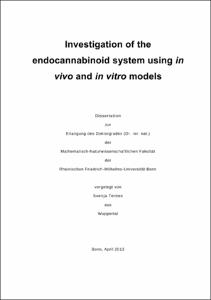Investigation of the endocannabinoid system using in vivo and in vitro models

Investigation of the endocannabinoid system using in vivo and in vitro models

| dc.contributor.advisor | Zimmer, Andreas | |
| dc.contributor.author | Ternes, Svenja | |
| dc.date.accessioned | 2020-04-18T22:17:23Z | |
| dc.date.available | 2020-04-18T22:17:23Z | |
| dc.date.issued | 31.07.2013 | |
| dc.identifier.uri | https://hdl.handle.net/20.500.11811/5724 | |
| dc.description.abstract | The endocannabinoid system (ECS) is a retrograde signaling system that plays an important, pro-homeostatic role in the central nervous system (CNS) by adjusting synaptic communication. The system comprises a set of presynaptic cannabinoid receptors and several different ligands (endocannabinoids), which are produced on the post-synaptic site of a synaptic connection. Upon release into the synaptic cleft, the endocannabinoids 2-AG (2-arachidonoyl glycerol) and anandamide (arachidonoyl ethanolamine, AEA) can bind and activate presynaptic cannabinoid receptors and thus initiate ECS-mediated signaling. Due to the fact that both endocannabinoids are capable of activating cannabinoid receptors, it is difficult to attribute a certain signaling effect to a certain endocannabinoid. To address this problem, this study aimed at generating conditional knockout mice for the 2-AG synthesizing enzymes DAGLα and DAGLβ. These mouse models will facilitate a detailed characterization of 2-AG-mediated signaling. Conditional targeting vectors were generated for both isoforms. The generation of conditional knockout mice was successful for the Daglα targeting construct. A set of preliminary behavioral experiments performed with homozygous Daglα knockout animals and a group of wild type animals initiated the behavioral phenotyping of this new mouse line. First results point out an important role of 2-AG-mediated signaling in anxiety and fear memory processing. ECS-mediated signaling is important to maintain homeostasis in healthy tissues. Besides this function, it also plays an important role under pathological conditions, as for example during an inflammatory response of the CNS. Microglial cells act as key players in neuroinflammation and have been shown to communicate via the ECS. In order to facilitate a better understanding of ECS-mediated signaling in microglial cells, a second part of this study focused on this versatile cell type. Different pro-and anti-inflammatory activation states of primary microglia were induced and characterized. Comprehensive gene expression profiling revealed that genes encoding cannabinoid receptors, as well as endocannabinoid synthesizing- and degrading enzymes are differentially regulated in microglia upon stimulation with pro-or anti-inflammatory substances. These data indicate an important function of the ECS in microglia and provide first insights into the regulation of ECS components in different microglial phenotypes. | |
| dc.language.iso | eng | |
| dc.rights | In Copyright | |
| dc.rights.uri | http://rightsstatements.org/vocab/InC/1.0/ | |
| dc.subject | Endocannabinoid-System | |
| dc.subject | Diacylglycerol lipase | |
| dc.subject | DAGL knockout | |
| dc.subject | 2-Arachidonoylglycerol | |
| dc.subject | Microglia | |
| dc.subject | Neuroinflammation | |
| dc.subject.ddc | 570 Biowissenschaften, Biologie | |
| dc.title | Investigation of the endocannabinoid system using in vivo and in vitro models | |
| dc.type | Dissertation oder Habilitation | |
| dc.publisher.name | Universitäts- und Landesbibliothek Bonn | |
| dc.publisher.location | Bonn | |
| dc.rights.accessRights | openAccess | |
| dc.identifier.urn | https://nbn-resolving.org/urn:nbn:de:hbz:5n-32924 | |
| ulbbn.pubtype | Erstveröffentlichung | |
| ulbbnediss.affiliation.name | Rheinische Friedrich-Wilhelms-Universität Bonn | |
| ulbbnediss.affiliation.location | Bonn | |
| ulbbnediss.thesis.level | Dissertation | |
| ulbbnediss.dissID | 3292 | |
| ulbbnediss.date.accepted | 03.07.2013 | |
| ulbbnediss.fakultaet | Mathematisch-Naturwissenschaftliche Fakultät | |
| dc.contributor.coReferee | Haas, Albert |
Files in this item
This item appears in the following Collection(s)
-
E-Dissertationen (4071)




